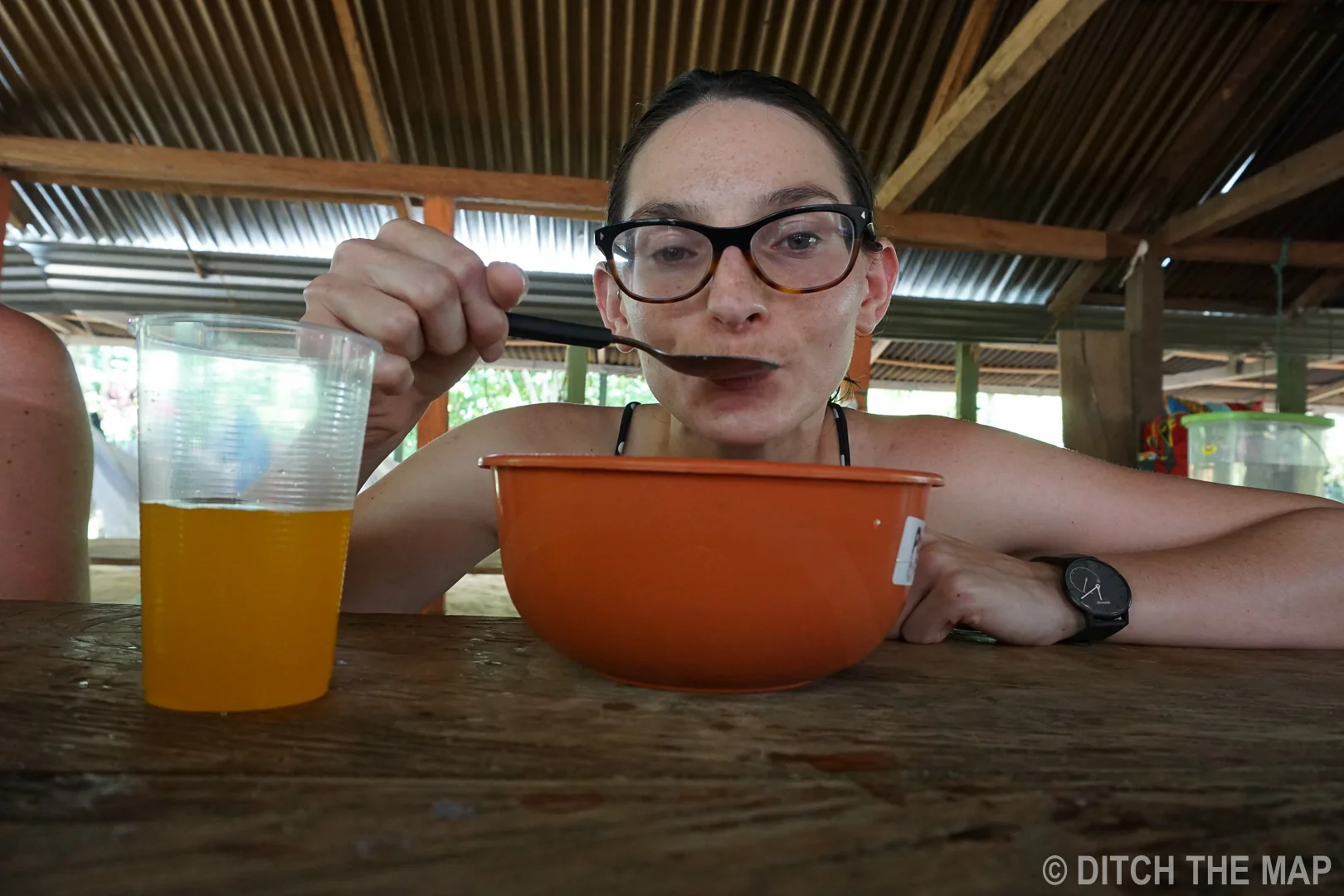5 Days Hiking The Lost City (Ciudad Perdida) Trek
/August 21-25, 2015
Typical Colombian Meal
We packed our daypacks for the 4-night (5-day) trek to the Lost City (Ciudad Perdida) of Colombia. Scott took 2 pairs of underwear, 2 pairs of socks, 2 shirts, one short and one pant. I also brought my sleep sheet, earplugs, hat, camera, hiking shoes, thongs, bug spray, sunscreen, toothbrush, deodorant, passport/wallet, sunglasses, and travel towel. We left our full packs behind—they are going to arrive with us at the hotel that we return to in 5 days.
We were anchovies in a can for 2 hours. After the off-road drive we arrived at Camp Machete where we were served our ‘typical’ Colombian lunch.
We were introduced to Alberto, our Kogi Indian guide, who had quite the unique disposition. 5 days with a guide who doesn’t speak a lick of English will sure be…interesting? Luckily Carmen, our G Adventure guide, could act as a translator. We are briefed on what to expect over the next 5 days (the places we will stop, the distances we would cover, etc.).
The heat was unbearable, the humidity insufferable, our packs were getting heavier by the minute. After a few water crossings we quickly learned who in our group would struggle with the trek. Within 20 minutes we arrived at our first, of many, swimming hole. We took each other’s photos as we jumped to the rejuvenating water below.
After a distance of uphill trekking we were reprieved by a ‘food stand’ where some of the group members bought Gatorade (4k pesos ~ $1.33 USD). A bit more strenuous hiking and we were awarded with some freshly cut watermelon. At this stop we came across quite a few dogs. We had noticed dogs following and leading us through the duration of our entire hike. It was actually adorable how the dogs would walk with us for a while and would turn their heads back and wait for us to catch up to them. This really makes me want a dog of my own to hike with. One of the dogs had a poorly splinted leg and had a large open wound at it hip. We had learned that a motorbike hit the dog recently. The owner of the dog, a local farmer, was tending to it. Carmen had shared some iodine and helped to lean the wound. Then the farmer took some antibiotic cream and rubbed it into the wound. It was a beautiful showing of human compassion as many trekkers stopped to watch. I really do hope that dog pulls through, but it seems like his odds are stacked against him.
First Campsite During the Lost City Trek
Dinner Our First Night During the Trek
After surviving a few downpours we finally arrived at our 1st campsite. A quarter of us slipped during the deep descent on the freshly wetted clay path. This camp was on the large side and had rows bunk beds with mosquito nets. We were all starved and ate our meals rather quickly. I got the fish and Sylvie the vegie option. The veggie meal consisted of highly salted…cheese? I thought it may have been rotten tofu, but it was probably just gross cheese.
After dinner we had the opportunity to ask Alberto questions about his life. We learned that he is a Kogi Indian—one of the 4 descending Indian tribes of the tribe that built the Lost City. He explained about his beliefs in creation, family structure, and various life values. Many of us took COLD showers and then went to bed after a few card games. By 8pm everyone was sound asleep. It was dark by 6:30 and by 7:00 the bugs were unbearable.
Two Indians Meeting and Exchanging Coca Leaves
Sylvie and I Enjoying the View
We woke up to roosters crowing before 5am, and were on the trek again before 6:30. We tried to get on the path as early as possible every day to beat the afternoon heat. Also, the afternoon rains started around 2pm. Halfway through the hike we were introduced to Manuel, our second tour guide. Manuel was a Wiwa Indian, another of the 4 tribes. Unlike the Kogi the Wiwa men wore hats—however both tribes dressed in all white. Prior to Manuel’s introduction we Witnessed Alberto giving an offering to Manuel. This ‘offering’ was dried coca leaves.
Panoramic of Colombian Jungle
All of the Indian men carry pouches of coca leaves on their side forpersonal use as well as to provide offerings to other Indian men they come across. The coca leaves are used in a few fashions. They always have a wad of coca leaves in their cheek. Secondly, they use a device that looks like a hollowed-out gourd to grind up coca leaves with lime juice and possibly something else (think mortar and pestle). This allows for a stronger extraction of the active ingredients in the coca leaves. This act creates a white powder that looks like cocaine. They then lick the end of the stick and scrape the end of the stick in a ritualistic fashion. The Indians feel that the use of the coca leaves promotes a spiritual balance.
MANUEL SHOWS US HOW HE CONVERT THE COCA LEAVES INTO A STRONGER "WHITE POWDER" (Click here to see video of how Manuel dries Coca Leaves)
A Female Wiwa indian picks coca leaves
At our second camp we were shown a coca plantation where we were able to dry the leaves ourselves. We also saw cocoa trees and tasted some. Even though we say a woman picking the coca leaves we later learned that females are prohibited from consuming the coca. Only the women were permitted the pick the leaves and it is believed that the plants would dry up if they were picked by men. Furthermore the women were only permitted to pick the leaves during their period. Manuel showed us how coca was dried and let us try the stronger dried leaves.
Manuel then demonstrated how to extract fibers, for weaving, from a cactus-looking plant. Just behind our beds were several Wiwa huts where women and children were living. We had the chance to interact with some of the children and one of the females in our group gave a few of them balloons. They were very cheerful. I was reminded of Africa when I say a young child (maybe 7 years old) carrying an infant around. The children seamed to be raised primarily by other children and the women of the tribe.
The morning of the 4th day we woke up exceptionally early (4:00) and began our longest day of hiking yet. After a river crossing, which required holding onto a braided metal rope with both hands, we commenced the final leg of the trek—1,650 stairs to the Lost City. Alberto provided information during the visit to the Lost City and on our way down we got to speak with a Shaman. We were told to provide offerings to the man, but all Sylvie had was a pack of 4 Oreo cookies that she was unwilling to part with. In my mind I kept thinking I wish I had a pack of Ramen so I could later say that I gave “Ramen to the Shaman”.
The Lost City was stunning—it looked like a finely trimmed golf fairway. The Lost City was an entire village that existed circa 500 CE but was only recently discovered by the western world in the mid 1970s. However, the local tribes knew of its existence but kept it from the ‘white man’. All that remained of the city were basic circular foundations. Over the last 4 decades excavations have revealed much more of the ancient ruins. The ruins are comprised of many terraces at level levels that seem to clime the entire mountainside. The Indians believe that the ancients who built the city have long since gone to another planet. However I recall Alberto saying something about how Indians shouldn’t kill frogs because they hold the human spirit? I forgot the details but it went something like this: frogs = people?
The Lost City
Manuel enjoying the view
Sylvie gets tired after so many stairs
The last one and a half days of hiking were tiring. Even though we hiked them at our own pace we still had to hike the distance it took us 3 days to get in…and in only a day and a half. Once we returned back to our initial place of departure we waited a while for everyone else to return. Then lunch and a 2-hour 4x4 truck ride to our hotel in Taganga. Internet, showers, and our own rooms…awesome! Too bad we didn’t have a/c or window screens. Sylvie and I went out to the beach and shopped around. We picked up some chocolate, suntan lotion, and fruit for the next day on the beach. We arrived at a restaurant on the beach and ordered two caprihyinas, a hamburger, and some ceviche—All for 51,000 Pesos ($17 USD). I gave the waitress a 50k and 10k bill and she handed me back the 10k bill and said keep it (or something like that in Spanish). In America this would never have happened.
I try some coca leaves
Sylvie holding a cocoa seed









